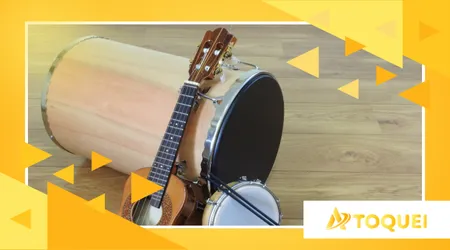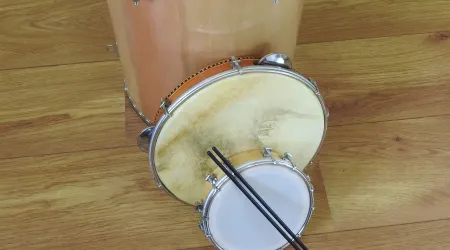Rebolo, tantan and repique de mão: differences and uses in pagoda

The rhythmic universe of pagode is vast and pulsating, anchored in an essential percussive trinity: the Grindstone, tantan and hand repique.
Advertisements
These drums, often confused by the uninitiated public, carry out distinct and crucial functions in the construction of the Brazilian batucada that dominates the circles and stages throughout the country.
The genre's unique sound is largely due to the sophisticated interplay of these instruments.
Identity and Function: Unraveling Each Instrument
The first and most fundamental distinction lies in the role of each piece in the balance of the music. They are not mere synonyms, but rather cogs in a precise musical clock.
Knowledge of its origins and techniques enhances the appreciation of any pagode song.
Advertisements
Tantan: The Spine of Rhythm
THE tantan is undeniably the backbone of the tempo. Its primary function is to mark the downbeat, acting as a modern and more portable substitute for the floor tom in smaller circles.
It is played laterally with the hands, producing a dry, fundamental bass.
Its robust sound establishes the basic pulse, allowing the other instruments to dance over it.
It's responsible for the stability and cohesion of the entire rhythm section. Without the tantan, the beat loses its sustain and sense of direction.
The Grindstone: Harmony and Contrast
++What is a dulcimer and where is it still used?
In contrast, the grinding wheel assumes a melodic and contrapuntal role in the percussion section.
Although it belongs to the same cylindrical family of drums, its higher tuning sets it apart. The musician holds it between their legs or uses a stand.
Its performance is marked by more complex and syncopated rhythmic cells. The grindstone fills the spaces between the tantan's beats.
He adds the harmonic-rhythmic “sauce”, maintaining a constant conversation with the cavaquinho line.
The Hand Repique: The Conduction of the Vanguard
Finally, the hand peal is the highest and most vibrant of the trio, acting as a conductor.
++Typical frevo instruments: a beginner's guide
The musician plays it with his fingertips and the palm of his hand, creating quick snaps and rolls.
He has the important mission of calling the turns.
Its bright, cutting sound serves to dictate speed and intensity.
This instrument introduces variations and breaks, injecting contagious energy.
++Ancestral Sounds: The Presence of Indigenous Instruments in Contemporary Brazil
Hand drumming requires refined technique and great precision from the percussionist.

Technical and Timbre Differences
The physical and timbre differences are the keys to immediately distinguishing them.
The tantan has a larger body, providing a deep, resonant bass. Its sound is the basis for sustain.
The grinding wheel is an intermediate size, generating a medium timbre, ideal for creating rhythmic phrases.
++Drummers, Tips, Percussion
It doesn't sound as full as the tantan, nor as poppy as the repique.
The hand peal, being the smallest and often tuned with greater tension, produces a sharp, crackling sound.
It cuts through the other instruments with ease. It's the instrument of rhythmic ornamentation.
A pertinent analogy to understand the dynamics is to think of them as the base, the body and the frosting of a cake.
The tantan is the base solid, the grinding wheel is the body that gives the flavor and the hand peal is the frosting that decorates and finishes with shine.
Uses and Interactions in the Context of Pagode
In the practical context of pagode, the performance of the three is a sonic choreography. The interaction between the Grindstone, tantan and hand repique defines the cadence of the samba.
The tantan maintains the unwavering rhythm and the grindstone edges upwards.
The hand repique introduces the mischievous syncopation and calls for change. It's in this dynamic that the pagode circle gains life and fluidity.
The percussionist knows the exact moment of each insertion.
1: Let's think of the beat of a samba-enredo, adapted to pagode: the tantan marks the head of the time, strong and sure (tum... tá...).
The grindstone weaves a swinging counter-beat (ta-tum-ta… ta-tum-ta…). The repique executes the final turn (titi-tá-tum!) for the entrance of the next verse.
2: In a slower, more romantic section, the Grindstone, tantan and hand repique decrease the intensity.
The tantan merely punctuates, the grindstone can almost fall silent, and the peal enters softly, almost like a velvety touch. The nuance defines the emotion.
Current Affairs and Technical Evolution
The contemporary nature of pagode, especially in its more popular forms, maintains the trio as a pillar.
However, the technique has evolved, incorporating influences from jazz and other genres. The performance demands greater virtuosity.
According to a 2023 study by the National Confederation of Commerce (CNC), the Brazilian creative industry, where popular music is central, grew 13.3% in the last year, demonstrating the economic and cultural strength of pagode.
This expansion drives appreciation and innovation in percussion.
| Instrument | Main Function | Dominant Timbre | Typical Position |
| Tantan | Time support | Serious, dry | Side, with hands |
| Grinding wheel | Rhythmic countermelody | Medium, velvety | Between the legs, with the hands |
| Hand Repeal | Driving and ornamentation | Sharp, cracking | Vertical, with fingers |
The great masters of percussion continue to inspire new generations of musicians who master the Grindstone, tantan and hand repique with mastery. The search for a clean and expressive sound is constant.
Conclusion: The Essential Triad
Understand the differences between the Grindstone, tantan and hand repique it's not just an exercise in music theory.
It's about immersing yourself in the essence of Brazilian culture. It's about recognizing the talent and complexity that lies within the apparent simplicity of a samba circle.
Pagode, with its captivating rhythm, is a living testament to the richness of our instrumentation. This percussive trinity will continue to dictate the rhythm of joy and popular emotion.
How can we ignore the power and cultural impact these drums have on our musical heritage?
Frequently Asked Questions
What is the main sound difference between the tantan and the grindstone?
The tantan is the instrument with the lowest, deepest sound, providing the basis for the rhythmic beat. The rebolo, on the other hand, has a medium timbre and is used to fill in and create more elaborate rhythmic phrases on this basis.
Which instrument in the trio is higher-pitched and used for calls?
The hand peal is the highest-pitched and most cutting. It's responsible for the calls, turns, and rapid rolls, injecting energy and driving the group's tempo.
Can all three instruments be played by the same person?
This isn't standard practice in group performance. Typically, each instrumentalist dedicates themselves to one piece, given the rhythmic complexity and the need for stability.
In small duets, a percussionist may occasionally alternate between grinding and hand pealing, but the tantan, because of its basic function, usually has a dedicated musician.
